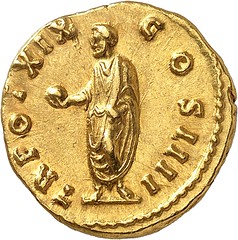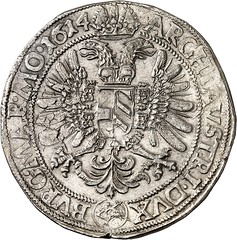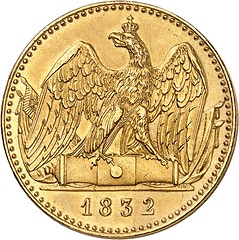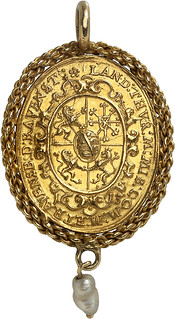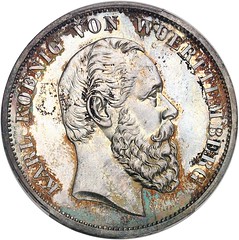
PREV ARTICLE
NEXT ARTICLE
FULL ISSUE
PREV FULL ISSUE
HEIDELBERGER MÜNZHANDLUNG GRÜN AUCTION 83This press release describes highlights from the November 2021 Heidelberger Münzhandlung Grün sale. -Editor ((1 - No. 2188. Teutonic Order. Maximilian I, 1590-1618. Taler 1603, Hall. Extremely fine to FDC. Estimate: 1,000 euros.)) As You Like It
Auction 83 provides collectors with the opportunity to choose the quality they want – or can
afford – their coin to be of. A good example for this is a taler by Maximilian I, since 1590
Grand Master of the Teutonic Order and since 1595 Regent of Upper Austria, which included
Tyrol and its mint in Hall. Therefore, the 1603 taler was minted in Hall. It is a splendid
specimen, and many features of it recall the first talers of Sigismund who was called Although we present extraordinary pieces of excellent quality in this preview, you can expect to find several dozen of just as interesting and way more affordable lots in auction 83. Like I said, estimates start in the lower two-digit range. ((2 - No. 46. Antoninus Pius, 138-161. Aureus. Very rare. Extremely fine +. Estimate: 8,000 euros.))
Celts, Greeks, Romans, Byzantines And lovers of Roman aurei and Byzantine solidi will also find a small but appealing selection. ((3 - No. 187. Mantua. Vincenzo I Gonzaga, 1587-1612. Ducatone of 12 bianchi n.d. Rare. Very fine. Estimate: 4,000 euros.))
Coins from Europe and all over the World ((4 - No. 673. China. Yunnan. Essay of a dollar n.d. with mirror-inverted edge inscription GOTT SEGNE UNS. Second known specimen, the best known specimen. Very rare. Very fine to extremely fine. Estimate: 3,500 euros.))
An Extremely Rare Chinese Pattern from Germany Another remarkable piece is a copper pattern of a dollar n.d., whose mirror-inverted edge inscription GOTT SEGNE UNS (God bless us) proves that the piece was produced in Germany, where many patterns for Chinese coins were minted. It seems to be the second known specimen. A specimen of significantly lower quality was offered at auction house Champion in Macao in February 2010, it had an estimate of $6,000-12,000. ((5 - No. 743. USA. 20 dollars 1905, Coronet Head Type. Rare. Only 59,011 specimens minted. Extremely fine to FDC. Estimate: 2,500 euros.)) Auction 83 lists more than 90 lots with American circulation and commemorative coins including numerous rarities such as a 20 dollar piece of 1905, of which only 59,011 specimens were minted. And of course the auction also contains a wealth of lots that are of interest to both collectors and gold investors. An example is a coin set in the original case from Venezuela issued in 1957 featuring leading persons of the Second World War on 18 gold medals, which have a weight of 22.2g each. The starting price of these about 360g of pure gold almost equals the material value and, at the same time, the set is a wonderful testimony to contemporary history. ((6 - No. 875. HRE. Matthias, 1612-1619. Taler 1614, Kuttenberg. Extremely fine to FDC. Estimate: 2,500 euros.))
Holy Roman Empire ((7 - No. 1659. Bavaria. William IV and Louis X, 1516-1545. Extremely rare. Slightly bent. Very fine. Estimate: 17,500 euros.)) ((8 - No. 1683. Bavaria. Maximilian II Emanuel, 1679-1726. Very rare. Extremely fine +. Estimate: 16,000 euros.))
German States with a Focus on Bavaria ((9 - No. 3343. Prussia. Frederick William III, 1797-1840. Double Frederick d'or, 1832. Extremely rare; year is missing in all known collections. Extremely fine. Estimate: 9,000 euros.)) ((10 - No. 3367. Prussia. Frederick William IV, 1840-1861. Gold medal of 12 ducats 1842 by Friedrich Anton König commemorating the wedding of Princess Maria with the Crown Prince Maximilian of Bavaria. Extremely rare. Extremely fine. Estimate: 20,000 euros.))
Rare Coins and Medals from Prussia ((11 - No. 3833. Saxe-Coburg-Eisenach. John Casimir, 1572-1633. Wearable oval gold gnadenpfennig 1613. Purchased in 1903 form the stock of Dr Eugen Merzbacher for 400 reichsmarks. 2nd known specimen. Extremely fine. Estimate: 15,000 euros.))
A Gnadenpfennig of Historical Importance ((12 - No. 2358. Pewter medal by J. Chr. Reich, 1783 commemorating the United Kingdom recognizing the United States of America. Extremely fine. Estimate: 300 euros.)) ((13 - No. 2502. Tauftaler (baptism taler) 1705, Zellerfeld. Extremely fine. Estimate: 400 euros.))
A Lot of Numismatics for Little Money In 1800, Johann Christian Reich was one of the most successful German engravers. Among other things, he was Prussian and Bavarian court medallist. He lived and worked in Fürth, where he did not only create works of art for powerful rulers, but also for small collectors. For them he issued historical medals made of pewter – the most affordable metal – of which a small series is on offer in auction 83. The example shown here recalls the Treaty of Paris in 1783, which formally ended the American War of Independence and specified that Great Britain recognized the independence of the United States of America. The second example is a tauftaler (baptism taler) of perfect quality as they were made in Zellerfeld as Christening gifts. Since early modern times it had been customary to give new- borns a coin to take with them on their journey through life. And if you are already thinking about whether there will soon be offspring of your relatives, you should know that auction 83 offers ten baptism talers with estimates between 100 and 400 euros.
((14 - No. 4763. German Empire. Saxony. 3 marks 1917 ((16 - No. 4953. Saxe-Meiningen. Georg II, 1866-1914. 20 marks 1882. Very rare. Almost FDC. Estimate: 27,500 euros.))
At Last a Glance at Grün's Specialty: Coins of the German Empire Coins from the German colonies, the Weimar Republic, the Third Reich and the FRG as well as patterns round off the auction, which Grün has scheduled to take place over the course of four and a half days. The auction catalogue can be purchased for the nominal fee of 12.50 euros at Heidelberger Münzhandlung Herbert Grün, Gaisbergstr. 40, 69115 Heidelberg, Germany; phone: +49 / 6221 / 65 2970; fax: +49 / 6221 / 65 297-29; email: kontakt@hdmhg.de. Of course, the catalogue is also available online, on Sixbid, biddr.com and Numisbids.
Wayne Homren, Editor The Numismatic Bibliomania Society is a non-profit organization promoting numismatic literature. See our web site at coinbooks.org. To submit items for publication in The E-Sylum, write to the Editor at this address: whomren@gmail.com To subscribe go to: https://my.binhost.com/lists/listinfo/esylum All Rights Reserved. NBS Home Page Contact the NBS webmaster 
|



